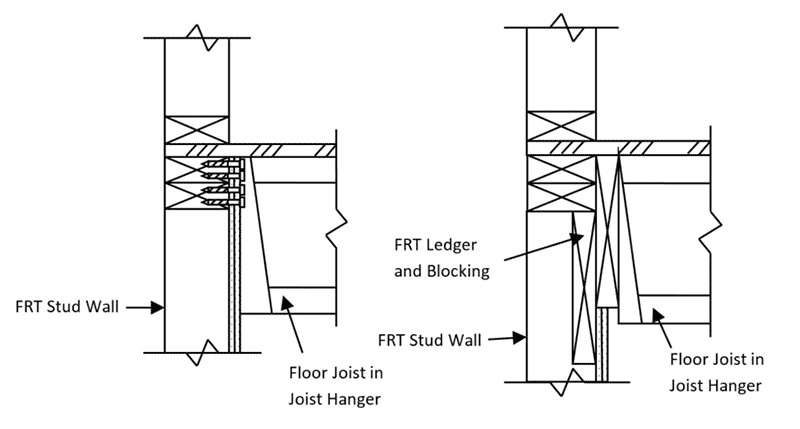Fire Rated Wood Construction Details
By Renee Strand
With the increasing popularity of wood-framed, mid-rise construction projects, there have been many questions regarding the appropriate way to frame the exterior wall at the floor intersection. Due to the size and number of stories of these buildings, they often fall into Type III construction, which is characterized by exterior walls of non-combustible material or fire-retardant-treated wood and the interior building elements can be of any material permitted by the code. The International Building Code (IBC) is clear on the requirements for the wall framing and floor framing but does not provide clarity where the floor framing intersects the wall.
Platform Framing – Sawn Lumber Framing
With platform framing, the rim board is required to transfer vertical and lateral wall loads through the structure and is normally considered a structural element of the wall framing by specifiers and building department officials. Thus, for Type III construction projects framed with wood exterior walls, the rim board at the exterior wall must be fire-retardant-treated (FRT) wood. Some jurisdictions have suggested that the ends of the floor joists bearing on top of the exterior wall should also be fire-retardant treated. However, this seems contrary to the IBC code, which clearly requires only the exterior wall framing to be of non-combustible material or FRT wood and allows floor framing to be of any material permitted by the code. The interior floor framing is typically protected gypsum in fire-resistance-rated assemblies as required by the code, but is not required to be of FRT wood. As defined in the IBC, FRT wood is any wood that is impregnated with chemicals by a pressure process or other means during manufacturing and meets stated performance requirements. The pressure process involves treating the full member length and not just the ends of a member. Therefore, since the code does not require FRT floor joists, the ends of the floor joists bearing on the exterior walls also do not need to be fire-retardant-treated. Additionally, the load path of the wall is not dependent on the floor joists, but rather the rim board which is FRT wood.
Plat form Framing – I-Joist Framing
For platform framing utilizing engineered wood I-joists for the floor framing, engineered wood lumber (I-joists, structural composite lumber) is recommended for the rim board material to ensure dimensional compatibility with the I-joists both at the time of installation and throughout the life of the structure. Sawn lumber and glulam beams are typically not suitable alternatives due to initial differences in depth and increased shrinkage. However, most engineered lumber products have not been evaluated for performance as a rim board after fire-retardant treatment. In fact, most manufacturers will void their product warranty if the product is pressure-treated with fire-retardant chemicals, because the pressure treatment process and chemicals used can negatively affect engineered lumber products. Evaluations of the effect of fire-retardant treatments on sawn lumber and plywood published by chemical treatment providers are not applicable to engineered lumber products.
Semi-balloon Framing
So what options exist for the specifier to properly detail the wall to floor intersection? Instead of platform framing, the walls can be framed taller and joists can hang from the top plate or a ledger attached to the wall (Figure 1). This option may add costs and time to the design and framing with the need for taller studs, additional shear wall length, eccentric loads, connections, blocking, and joist hangers. If two layers of gypsum wall board are required on the interior face of the stud wall for the fire-resistance rating, the specifier must specify hangers that can support the loads for installation over the gypsum wall board or specially-designed hangers specific to this application.

Common Platform Framing
What if commonly used platform framing is desired? The challenge is finding a rim board of compatible height that won't shrink to less than the height of the joists, so it maintains its ability to transfer both vertical and lateral loads. A rim board that shrinks below the height of the I-joist will allow vertical wall loads to transfer to the I-joist resulting in crushing. A gap between the floor sheathing and the rim will reduce the lateral shear transfer as well. Occasionally a specification is seen for dimension lumber used as a rim with a filler to try and obtain an equivalent height to the I-joists. This is a time consuming solution that does not guarantee a compatible rim height for the I-joists after the lumber shrinks, and does not address the reduction in lateral capacity. This approach is not recommended. FRT glulam beams or laminated veneer lumber are commonly specified, but most of these products have not been evaluated for rim board applications after fire-retardant treatment. The water and chemicals introduced in the treatment process may cause reductions in strength and fastener values with these products. Published evaluations of these effects on sawn lumber and plywood are not applicable to engineered wood products. Swelling, cupping, and unrecoverable dimensional changes with these products result in framing hassles for the contractor and a risk that loads will not follow the intended load path.
Heavy Timber Rim Board
Some specifiers have been successful in using a thick engineered wood rim board with width that meets the requirements of Type IV construction (heavy timber) and hanging the joists from the rim. This option is not addressed in the code and needs local jurisdiction approval. It also adds costs in labor and hangers.
Field-applied Coatings
What other options currently exist? Some areas have accepted field-applied coatings. Many proclaim they have a Class A flame spread defined as a flame spread index of 25 or less. However, a Class A flame spread is not equivalent to FRT wood. 2012 IBC, Section 2303.2 requires FRT wood to be tested in accordance with ASTM E84, achieve a flame spread index of 25 or less,and show no evidence of significant progressive combustion when the test is continued for an additional 20 minutes. Additionally, the flame front cannot progress more than 10.5 ft from the centerline of the burners at any time during the test. The specifier should ensure that all of these performance requirements are met when using field-applied coatings. Other items to consider when allowing field-applied coatings is assuring the application is uniformly applied at the proper thickness and follows proper drying times between additional coats as required by the manufacture.
Maintaining a 2-hr Fire-Rated Wall Assembly
In addition to the requirement for exterior wall framing to be non-combustible or fire-retardant-treated wood, the exterior walls typically need to have a 2-hour fire-resistance rating. Again, the code is not clear on what happens at the wall to floor intersections. Weyerhaeuser has proposed details that have been evaluated by Intertek Testing Services and are shown in Figure 3 which was taken from Weyerhaeuser's Fire-Safe Construction and Sprinkler Systems Guide 1500, designs 3A and 3B.
An alternative to protecting the rim with one layer of 5/8″ Type X gypsum board when there is a one-hour fire-rated floor ceiling assembly, is to protect the rim with 1.75″ thick TimberStrand LSL (Figure 2). Structurally, 1.75" wide TimberStrand LSL rim is often sufficient to transfer vertical and lateral loads. Adding in an additional sacrificial 1.75" wide TimberStrand LSL, or using a single 3.5" wide rim, provides more than one hour of fire protection. Summing protection from the one hour ceiling assembly and the sacrificial 1.75" thickness of rim, demonstrates that a total of 2 hours of fire protection is provided to the rim space. For more information regarding a 2-hr fire-resistance rated assembly please contact your local Trus joist representative.

RENEE STRAND

Source: https://www.weyerhaeuser.com/blog/mid-rise-wood-framed-type-iii-construction-how-to-frame-the-floor-to-wall-intersection-at-exterior-walls/
Posted by: sondrakulishe0189411.blogspot.com